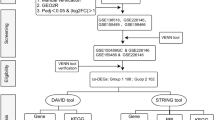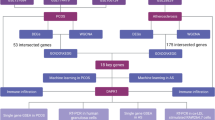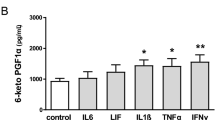Abstract
In congenital heart disease with left- or right-sided obstruction, prostaglandin E (PGE)1 or PGE2 is infused to maintain ductus arteriosus (DA) patency. We hypothesized that transfection of the DA with PGE synthase would lead to a greater production of PGE2 in situ and, hence, patency of the DA. The cDNA for human prostaglandin synthase was sequenced and ligated into a eukaryotic expression vector. The negative control was created by ligating the cDNA encoding the bacterial protein chloramphenicol acetyltransferase into the same plasmid. Transfection (600 μg DNA) was achieved in lambs within the first 24 h of life using the hemagglutinating virus of Japan (HVJ)-liposome transfection method with a custom-made, basket-weave-perforated catheter. Echocardiography was performed to assess DA patency until the time of sacrifice. To confirm expression of the transgene, PGE2 concentration was measured in organ culture of the DA by immunoassay and by Western immunoblotting of homogenized DA tissue. Patency of the DA was demonstrated by color Doppler in all the lambs (7/7) in which the PGE synthase was delivered, whereas functional closure was seen in the control group (6/6). The PGE2 concentration in the culture medium of the explanted DA in the treatment group was 3-fold higher than that of the control groups. Western immunoblotting confirmed the presence of PGE synthase in the treatment group. Gene transfer of PGE synthase to the DA is feasible and will maintain patency for at least 1 wk.
Similar content being viewed by others
Log in or create a free account to read this content
Gain free access to this article, as well as selected content from this journal and more on nature.com
or
Abbreviations
- CAT:
-
chloramphenicol acetyltransferase
- DA:
-
ductus arteriosus
- ET-1:
-
endothelin-1
- HVJ:
-
hemagglutinating virus of Japan
- PGE2:
-
prostaglandin E2
References
Rabinovitch M, Boudreau N, Vella G, Olley PM 1987 Prostaglandin synthesis in fetal ductus arteriosus pulmonary artery and aorta endothelial and smooth muscle cells. Pediatr Res 21: A–387
Coceani F, Kelsey L, Seidlitz E 1992 Evidence for an effector role of endothelin in closure of the ductus arteriosus at birth. Can J Physiol Pharmacol 70: 1061–1064
Coceani F, Liu Y, Seidlitz E, Kelsey L, Kuwaki T, Ackerley C, Yanagisawa M 1999 Endothelin A receptor is necessary for O(2) constriction but not closure of ductus arteriosus. Am J Physiol 277: H1521–H1531
Clyman RI, Mauray F, Roman C, Heymann MA, Payne B 1983 Factors determining the loss of ductus arteriosus responsiveness to prostaglandin E. Circulation 68: 433–436
Coceani F, Olley PM 1988 The control of cardiovascular shunts in the fetal and perinatal period. Can J Physiol Pharmacol 66: 1129–1134
Babyn P, Peled N, Manson D, Dagan O, Silver MM, Koren G 1995 Radiologic features of gastric outlet obstruction in infants after long-term prostaglandin administration. Pediatr Radiol 25: 41–43
Heymann MA, Clyman RI 1982 Evaluation of alprostadil (prostaglandin E1) in the management of congenital heart disease in infancy. Pharmacotherapy 2: 148–155
Kramer HH, Sommer M, Rammos S, Krogmann O 1995 Evaluation of low dose prostaglandin E1 treatment for ductus dependent congenital heart disease. Eur J Pediatr 154: 700–707
Lewis AB, Freed MD, Heymann MA, Roehl SL, Kensey RC 1981 Side effects of therapy with prostaglandin E1 in infants with critical congenital heart disease. Circulation 64: 893–898
Peled N, Dagan O, Babyn P, Silver MM, Barker G, Hellmann J, Scolnik D, Koren G 1992 Gastric-outlet obstruction induced by prostaglandin therapy in neonates. N Engl J Med 327: 505–510
Tanner FC, Carr DP, Nabel GJ, Nabel EG 1997 Transfection of human endothelial cells. Cardiovasc Res 35: 522–528
Jakobsson PJ, Thorén S, Morgenstern R, Samuelsson B 1999 Identification of human prostaglandin E synthase: a microsomal, glutathione-dependent, inducible enzyme, constituting a potential novel drug target. Proc Natl Acad Sci U S A 96: 7220–7225
Dick A, Kromen W, Jüngling E, Grosskortenhaus S, Kammermeier H, Vorwerk D, Günther RW 1999 Quantification of horseradish peroxidase delivery into the arterial wall in vivo as a model of local drug treatment: comparison between a porous and a gel-coated balloon catheter. Cardiovasc Intervent Radiol 22: 389–393
Dzau VJ, Mann MJ, Morishita R, Kaneda Y 1996 Fusigenic viral liposome for gene therapy in cardiovascular diseases. Proc Natl Acad Sci U S A 93: 11421–11425
Fineman JR, Takahashi Y, Roman C, Clyman RI 1998 Endothelin-receptor blockade does not alter closure of the ductus arteriosus. Am J Physiol 275: H1620–H1626
Flugelman MY, Jaklitsch MT, Newman KD, Casscells W, Bratthauer GL, Dichek DA 1992 Low level in vivo gene transfer into the arterial wall through a perforated balloon catheter. Circulation 85: 1110–1117
Guerguerian AM, Hardy P, Bhattacharya M, Olley P, Clyman RI, Fouron JC, Chemtob S 1998 Expression of cyclooxygenases in ductus arteriosus of fetal and newborn pigs. Am J Obstet Gynecol 179: 1618–1626
Kaneda Y 1994 Virus (sendai virus envelopes)-mediated gene transfer. In: Celis JE (ed) Cell Biology: A Laboratory Handbook. Academic Press, San Diego, pp 50–57
Mason CA, Bigras JL, O'Blenes SB, Zhou B, McIntyre B, Nakamura N, Kaneda Y, Rabinovitch M 1999 Gene transfer in utero biologically engineers a patent ductus arteriosus in lambs by arresting fibronectin-dependent neointimal formation. Nat Med 5: 176–182
Alfke H, Wagner HJ, Calmer C, Klose KJ 1998 Local intravascular drug delivery: in vitro comparison of three catheter systems. Cardiovasc Intervent Radiol 21: 50–56
Baumbach A, Herdeg C, Kluge M, Oberhoff M, Lerch M, Haase KK, Wolter C, Schröder S, Karsch KR 1999 Local drug delivery: impact of pressure, substance characteristics, and stenting on drug transfer into the arterial wall. Catheter Cardiovasc Interv 47: 102–106
Wolinsky H, Thung SN 1990 Use of a perforated balloon catheter to deliver concentrated heparin into the wall of the normal canine artery. J Am Coll Cardiol 15: 475–481
Ibe BO, Hibler S, Raj JU 1998 Platelet-activating factor modulates pulmonary vasomotor tone in the perinatal lamb. J Appl Physiol 85: 1079–1085
Hacein-Bey-Abina S, von Kalle C, Schmidt M, Le Deist F, Wulffraat N, McIntyre E, Radford I, Villeval JL, Fraser CC, Cavazzana-Calvo M, Fischer A 2003 A serious adverse event after successful gene therapy for X-linked severe combined immunodeficiency. N Engl J Med 348: 255–256
Kaneda Y, Saeki Y, Morishita R 1999 Gene therapy using HVJ-liposomes: the best of both worlds?. Mol Med Today 5: 298–303
Lawrie A, Brisken AF, Francis SE, Cumberland DC, Crossman DC, Newman CM 2000 Microbubble-enhanced ultrasound for vascular gene delivery. Gene Ther 7: 2023–2027
Clyman RI, Hardy P, Waleh N, Chen YQ, Mauray F, Fouron JC, Chemtob S 1999 Cyclooxygenase-2 plays a significant role in regulating the tone of the fetal lamb ductus arteriosus. Am J Physiol 276: R913–R921
Coceani F, Ackerley C, Seidlitz E, Kelsey L 2001 Function of cyclo-oxygenase-1 and cyclo-oxygenase-2 in the ductus arteriosus from foetal lamb: differential development and change by oxygen and endotoxin. Br J Pharmacol 132: 241–251
Loftin CD, Trivedi DB, Tiano HF, Clark JA, Lee CA, Epstein JA, Morham SG, Breyer MD, Nguyen M, Hawkins BM, Goulet JL, Smithies O, Koller BH, Langenbach R 2001 Failure of ductus arteriosus closure and remodeling in neonatal mice deficient in cyclooxygenase-1 and cyclooxygenase-2. Proc Natl Acad Sci U S A 98: 1059–1064
Clyman RI 1987 Ductus arteriosus: current theories of prenatal and postnatal regulation. Semin Perinatol 11: 64–71
Coceani F, Huhtanen D, Hamilton NC, Bishai I, Olley PM 1986 Involvement of intramural prostaglandin E2 in prenatal patency of the lamb ductus arteriosus. Can J Physiol Pharmacol 64: 737–744
Coceani F, Kelsey L 1991 Endothelin-1 release from lamb ductus arteriosus: relevance to postnatal closure of the vessel. Can J Physiol Pharmacol 69: 218–221
Bouayad A, Kajino H, Waleh N, Fouron JC, Andelfinger G, Varma DR, Skoll A, Vazquez A, Gobeil F Jr, Clyman RI, Chemtob S 2001 Characterization of PGE2 receptors in fetal and newborn lamb ductus arteriosus. Am J Physiol Heart Circ Physiol 280: H2342–H2349
Acknowledgements
The authors thank Cameron Slorach, Echo Technologist, Hospital for Sick Children, Toronto, Ontario, Canada, for technical assistance during echocardiography of the animals.
Author information
Authors and Affiliations
Corresponding author
Additional information
Supported by a grant from the Canadian Institutes of Health Research MT723 and from the Martin Foundation through the Hospital for Sick Children Foundation. M.R. is an endowed chair of the Heart and Stroke Foundation of Ontario and a Distinguished Scientist of the Canadian Institutes of Health Research MT 723.
Rights and permissions
About this article
Cite this article
Humpl, T., Zaidi, S., Coe, J. et al. Gene Transfer of Prostaglandin Synthase Maintains Patency of the Newborn Lamb Arterial Duct. Pediatr Res 58, 976–980 (2005). https://doi.org/10.1203/01.PDR.0000182820.20333.2A
Received:
Accepted:
Issue date:
DOI: https://doi.org/10.1203/01.PDR.0000182820.20333.2A



